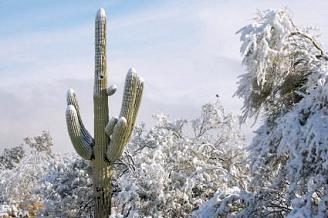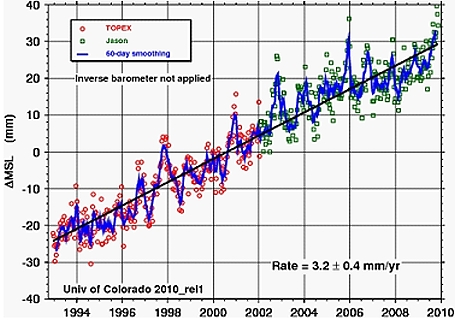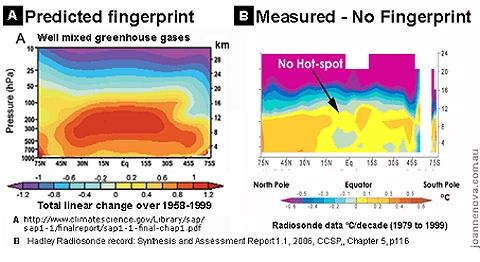No, Dr Glikson
 |
Dr Andrew Glikson says the right motherhood lines [see: Case for Climate Change]: he talks about empirical evidence, and wants evidence based policies. All this is good, yet he sidesteps the main point — what exactly is the evidence for the theory of man-made global warming? It’s the only point that matters, yet when he presents evidence it’s either not empirical, not up to date, or not relevant. Why?
By hitting all the right key phrases a reader might accidentally think that Glikson is presenting key evidence and good reasoning. Take this for example: Glikson fears we’re turning away from evidence-based policies. (Me too!) But to complete the sentence he lists all the committees who predict bad weather 90 years from now. It makes for good PR, but is not scientific evidence.
Committee reports count as “evidence” in a court of law, but in science, certificates, declarations, contracts, commission hearings, or 3000 page reports don’t mean anything. Clouds don’t give a toss about what committees predict.
Irrelevant and incorrect
Arctic ice and sea levels are at least empirical evidence, but in this case, they’re irrelevant.
They don’t tell us anything about what caused the warming. Almost any cause of warming would melt sea ice. Then there’s the problem that global sea ice is looking fairly robust. The Arctic has shrunk some, but the Antarctic has grown. Each year millions of square kilometres of ice melt on each half of the globe, and each year they also refreeze. Peak global sea ice is roughly the same now as it was in 1979.[i] And far from being “worse than expected,” Arctic sea ice in 2010 is breaking records—still growing until the end of March.[ii]
Rising sea-levels are similar—they’re evidence of warming, but not evidence that carbon caused the warming. And as far as the “it’s worse than we thought” theme goes: where is the scary surprising uptick? If anything, instead of an upcurve, the graph has slightly flattened off. The trend is utterly predictable, except that it might be rising less fast than the predictions.
Any careful scientist ought to be very qualified in using statements implying “accelerating trends”. Unfounded claims about the need to rush in and sign the dotted line are like a sales pitch: Hurry, last chance! Don’t wait for more evidence...

Note that sea levels have been rising for 200 years. Long before humans emitted significant amounts of CO2. Half of man-made CO2 has been emitted in the last 35 years, but the trendline remains the same before and after.
Harmful carbon?
Glikson also tries to suggest that carbon is only beneficial for plants in glasshouses “where humidity is high”. Awkwardly for him, field studies from fifty years ago show that atmospheric carbon dioxide is the rate-limiting factor for plants — meaning they use up all the CO2 they can between sunrise and 12 noon each day, then slow down until the carbon levels are restored in the air overnight.[iii] One of the main purposes for water molecules in plant tissue is to be exchanged for CO2 (known as evapotranspiration), so not surprisingly not only do plants prefer higher CO2 — they grow faster — they also cope better with drier conditions. Overall, hundreds of studies show that plants typically grow 20-50% more biomass with higher CO2 levels.[iv]
Curiously Glikson mentions hypercapnia in the same paragraph and associates carbon dioxide with arsenic, mercury and cyanide. But as every toxicologist knows, any chemical will become a poison at high enough concentrations. Glikson’s comparison is “true”, but mindless. Pure oxygen and water can kill you too. Knowing that does not help us decide what to do with carbon. As for hypercapnia, in humans it begins to have noticeable effects at around 75,000 ppm, which at present rates of increase will become an issue sometime around the year 39,000AD. (Look out for the onset of global headaches in 37,000 years.)
But seriously, what about ocean acidification? It’s worth noting that fears of ocean acidification are largely theoretical and calculated, rather than based on empirical evidence. Some corals grown in very high levels of CO2 thrived. When one research team reconstructed ocean pH levels with boron isotopes in corals, they found no noteable trend over the last 300 years[v] or the last 6000 years.[vi] Atmospheric CO2 levels may have risen 30% recently, but at least in that marker, there’s no clear relationship between ocean acidity and atmospheric CO2. Other researchers found warmer temperatures increased calcification along the full length of the Great Barrier Reef.[vii]
Wherefore art thou reasoning?
Even the IPCC has admitted the 2035 projection for the complete melting of the Himalayas was baseless (and probably a Chinese-whispers type mistake from someone misreading “2350” as 2035). Despite this, Glikson hints that it’s possible the Himalayas could even melt before 2035. His evidence? Not a peer reviewed paper on glaciers or a study of the Himalayas, but a study that showed the IPCC reports underestimated “other things”. Really. Whether a committee makes bad projections is not remotely admissible as evidence of whether kilometre wide glaciers will disappear “unexpectedly”. Why should I need to explain this to a professor? (What has happened to Australian universities?)
Endorsing “low quality” science
Glikson comments on the recent unauthorised release of emails from East Anglia, saying they hardly amount to a “ClimateGate” conspiracy by the scientific community. As usual, what he doesn’t say is revealing. Since he doesn’t admonish Jones and Mann for their petty, unprofessional behaviour, their attempts to hide data from other scientists, or to avoid FOIs and boasts of intimidating journal editors, does that mean he thinks these are acceptable? They talked about producing error bars that “might be wrong”, they cherry picked and hid sections of graphs, and they asked groups of people to delete emails and hide files. If mass emails suggesting dishonest things is not a conspiracy, what is? Either Glikson hasn’t read the emails, or he condones this. Where are the real climate scientists who stand up for transparent honest science, for verification and replication of results? If he wants us to trust them like medical doctors, we need to know that most climate scientists aim higher than “hiding declines”.
Before anyone howls that the raw data is all available, note that only the adjusted data is available, not the raw data. The UK Met Centre admits it will take three years to reassemble the data.
Fake principles
Glikson says the root of the debate is the precautionary principle, but there is no scientific principle about “precaution”. It’s a catchy PR term that works just as well for skeptics (except we don’t stoop to invoke it). Sensible public policy is based instead on a risk-benefit ratio. The best, most detailed information we have from hundreds of studies, thousands of boreholes, kilometres of ice cores, and hundreds of thousands of weather balloon and satellite recordings tells us that it’s likely there is little risk of catastrophic warming, and little benefit in reducing carbon emissions. Therefore, we should do only the easy, cheap things to reduce emissions, while keeping watch on the data, and focus our efforts instead on real problems.
What evidence do we need?
More than anything else, we need to know how much of the recent warming has been directly due to our carbon emissions and how much has been natural. We need this predict how much warming we might get this century. The “how much” question is the 200Gt gorilla in the kitchen. Half a degree or three-and-half degrees makes all the difference. But since both natural and unnatural warming causes glaciers to melt, seas to rise, and rainfall patterns to change, how do we know how much of past warming is due to us?
The central problem with “attribution” of the cause for the warming is that dozens of major forces are working on our climate, and none of them leave a business card.
Even James Hansen and the IPCC agree that carbon dioxide, by itself, will theoretically warm us only by about 1.1 degrees if CO2 levels double (as they will have, from 1750 to the end of this century). All the papers Glikson mentions, like Arrhenius, Calendar and Keeling, agree with this calculation, as do most skeptics.
What turns this single degree into a “disaster” in their theory, worth taxing every citizen on the planet for, are the feedbacks—meaning what do clouds, humidity, ice cover, bushes, trees and plankton do in a world that’s tending to be one degree warmer due to extra CO2? Does the extra humidity form the kind of clouds that trap more heat or the kind that reflect more sunlight? The first amplifies the warming, and the other dampens it.
The models all reckon the feedbacks amplify the warming, but three independent sources of empirical evidence suggests the opposite occurs, and that the feedbacks are negative (ie. they “dampen”). In that case the headline threat reads Half a Degree.[viii]
The feedbacks are crucial to the model predictions. Without feedbacks, there’s no warming more than 1.1 degrees And just to make it more complicated, the major feedbacks are with water vapor— both the main greenhouse gas and what makes clouds.
All the major climate models predicted that increasing non-water-vapor “greenhouse gases” would warm the atmosphere mostly at around 10km above the tropics. Weather balloons have been measuring temperature and humidity since the 1950s, and are individually calibrated to 0.1 degrees. There are hundreds of thousands of measurements from around most of the world.
Compare the model predictions to the weather balloon measurements below. The graphs are not remotely the same. The models are wrong. The “Hot Spot” is missing. The net effect of the warming due to man-made CO2 has been exaggerated.

Andrew Glikson doesn’t mention the hot-spot.
NOTES:
[i] University of Illinois at Urbana-Champaign : Cryosphere http://arctic.atmos.uiuc.edu/cryosphere/IMAGES/global.daily.ice.area.withtrend.jpg
[ii] Arctic Sea Ice 2001-2020 http://www.ijis.iarc.uaf.edu/seaice/extent/AMSRE_Sea_Ice_Extent.png
[iii] H. W. Chapman, L. S. Gleason, W. E. Loomis , The Carbon Dioxide Content of Field Air, Plant Physiology, Vol. 29, No. 6 (Nov., 1954), pp. 500-503
[iv] Plant Dry Weight Responses to Atmospheric Enrichment, Centre For The Study Of Carbon Dioxide And Global Change. http://www.co2science.org/data/plant_growth/dry/dry_subject.php
[v] Pelejero, C., Calvo, E., McCulloch, M.T., Marshall, J.F., Gagan, M.K., Lough, J.M. and Opdyke, B.N. 2005. Preindustrial to modern interdecadal variability in coral reef pH. Science 309: 2204-2207.
[vi] Liu, Y., Liu, W., Peng, Z., Xiao, Y., Wei, G., Sun, W., He, J. Liu, G. and Chou, C.-L. 2009. Instability of seawater pH in the South China Sea during the mid-late Holocene: Evidence from boron isotopic composition of corals. Geochimica et Cosmochimica Acta 73: 1264-1272.
[vii] Lough and Barnes 1997 and 2000 as described in CO2, Global Warming and Coral Reefs, Dr Craig Idso, p48-51.
[viii] Lindzen, R. S., and Y.-S. Choi (2009), On the determination of climate feedbacks from ERBE data, Geophys. Res. Lett., 36, L16705, doi:10.1029/2009GL039628. (Also updated in 2010); Spencer, R.W., Braswell, W.D., Christy, J.R., Hnilo, J., 2007. Cloud and radiation budget changes associated with tropical intraseasonal oscillations. Geophysical Research Letters, 34, L15707, doi:10.1029/2007/GL029698; Douglass, D.H., J.R. Christy, B.D. Pearson, and S.F. Singer. 2007. A comparison of tropical temperature trends with model predictions. International Journal of Climatology.
___________________________________________________________________________________
Source: http://www.quadrant.org.au/blogs/doomed-planet/2010/04/joanne-nova
























